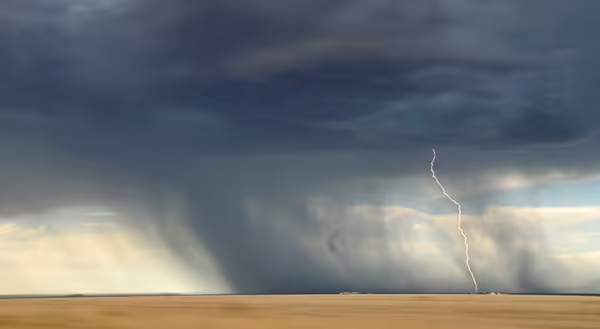
We tested your knowledge last month. Did you pass the test?
- True or False: Due to the Greenhouse Effect, the earth takes in more heat from the sun than it gives off.
FALSE: What greenhouse gases do is slow the release of heat. If the earth really took in more heat than it received from the sun, the earth would be much, much hotter.
- An increase in temperature the higher you go in the atmosphere is called a (BLANK BLANK).
ANSWER: An increase in temperature with height is called a Temperature Inversion. This occurs more often than you think. On clear calm nights, the ground may cool very quickly, which cools the air right above it. This creates a temperature inversion at earth's surface, which may go up only a few feet or dozens of feet. Fog sometimes occurs in combination with a temperature inversion.
- The eye of a hurricane has calm winds and clear skies because the air is doing what there?
ANSWER: As air rises close to the center of the hurricane, once it gets up thousands of feet, it starts moving horizontally. Some spreads away the center, but some moves towards the center of the hurricane. As this air moves inward, the air compresses and gets heavier, causing it to sink. Sinking air creates the clear sky and calm winds in the eye at the surface.
- True or False: Visible band satellite imagery is equally useful day or night.
ANSWER: Using only the light humans see does not work well at night because, well, things are dark. If you look at satellite imagery of earth using the visible spectrum where there is no sunlight there is nothing to see. Infrared imagery, which detects wavelengths of light humans cannot see, shows clouds, water vapor, and many other things always. The instruments that show us this imagery assign colors to ranges of wavelengths, providing more information such as height of clouds.
- If the outside temperature is 50 degrees Fahrenheit and the relative humidity is 100%, what is the dew point temperature?
ANSWER: When the air is holding as much water vapor as it can hold, which is the same as 100% relative humidity, it’s at its dew point temperature. So the answer in this case is 50 degrees Fahrenheit. Dew point temperatures change because the amount of water vapor in the air is always changing.
- In 1969, pop singer B.J. Thomas said these were falling on his head.
ANSWER: B.J Thomas said that raindrops were falling on his head. This was an instrumental by Burt Bacharach for the movie Butch and the Sundance Kid starring Robert Redford and Paul Newman; later it became a pop hit when Thomas sang the lyrics. I am now envisioning a bunch of searches taking place.
- Cloud seeding typically uses (BLANK BLANK) to enhance chances for precipitation.
ANSWER: Silver iodide mimics other particles like dust, smoke particles, and leaf bacteria, called condensation nuclei, that must be present in the air for condensation to occur. Just seeding air randomly will not make it rain. Research in California on cloud seeding in the northern part of the state shows it may increase precipitation by 10% at most.
- Low pressure is associated with (BLANK) weather.
ANSWER: When you see that L on a weather map, that is indicating an area of low air pressure. If you watch the weather, you will see that cloudiness or unsettled weather is associated with lower air pressure.
- As air rises in the atmosphere, these two things happen to it.
ANSWER: Rising air will expand as it rises, because, like a balloon, the rising air is moving into air that is less dense, allowing air molecules to spread apart. As they move apart, they do not bang into each other as much, so the air also cools.
- True or False Large tornadoes often have multiple funnels.
ANSWER: Studies of tornadoes have shown that very large tornadoes many times have multiple funnels rotating around a central area. This helps explain why, in some neighborhoods, some houses are destroyed and other houses are not. If one of the funnels that has air speeds of 150 miles per hour hits a house, it will do a lot of damage. If a house on the other side of the street is not directly hit by a funnel and the wind there is only 80 miles an hour, much less damage will be done. Because of all the debris in the vicinity, it looks like one big tornado, but multiple vortices are within the debris cloud.
How did you do? We’ll keep the quizzes coming periodically.
ABOUT THE BLOG: All About Weather explores the environment, climate, and weather topics for Illinois. Get in-depth information about things your weather app doesn't cover from summer droughts to shifting weather patterns. Never miss a new post! Sign up for our email list.
MEET THE AUTHOR: Duane Friend is the Illinois Master Naturalist Coordinator and Climate Specialist with University of Illinois Extension, serving the organization in many roles since 1993. Duane provides information and educational programs to adult and youth audiences in the areas of soil quality, weather and climate, energy conservation, and disaster preparedness. These programs provide practical solutions for families, farms, and communities. He assists families in creating a household emergency plan, farmers with the implementation of soil management and conservation practices, and local government officials and business owners with energy conservation techniques.